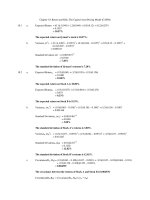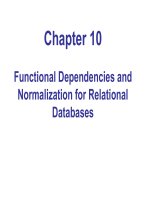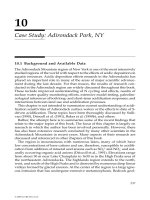OB11 chapter 10 communication
Bạn đang xem bản rút gọn của tài liệu. Xem và tải ngay bản đầy đủ của tài liệu tại đây (520.91 KB, 31 trang )
eleventh edition
organizational
behavior
stephen p. robbins
Chapter 10
Communication
ORGANIZATIONAL BEHAVIOR
S T E P H E N P. R O B B I N S
E L E V E N T H
© 2005 Prentice Hall Inc.
All rights reserved.
E D I T I O N
WWW.PRENHALL.COM/ROBBINS
PowerPoint Presentation
by Charlie Cook
OBJECTIVES
LEARNING
After studying this chapter,
you should be able to:
1. Describe the communication process.
2. Contrast the advantages and disadvantages of
oral versus written communication.
3. Compare the effectiveness of the chain, wheel,
and all-channel networks.
4. Identify the factors affecting the use of the
grapevine.
5. Discuss how computer-aided technology is
changing organizational communication.
© 2005 Prentice Hall Inc.
All rights reserved.
10–
3
O B J E C T I V E S (cont’d)
LEARNING
After studying this chapter,
you should be able to:
6. Explain the importance of channel richness to
improving communication effectiveness.
7. Identify common barriers to effective
communication.
8. Describe the potential problems in crosscultural communication.
© 2005 Prentice Hall Inc.
All rights reserved.
10–4
Functions
Functions of
of Communication
Communication
Communication
The transference and the understanding of
meaning.
Communication
CommunicationFunctions
Functions
1.
1. Control
Controlmember
memberbehavior.
behavior.
2.
2.
3.
3.
Foster
Fostermotivation
motivationfor
forwhat
whatisisto
tobe
bedone.
done.
Provide
Provideaarelease
releasefor
foremotional
emotionalexpression.
expression.
4.
4. Provide
Provideinformation
informationneeded
neededto
tomake
make
decisions.
decisions.
© 2005 Prentice Hall Inc.
All rights reserved.
10–5
Elements
Elements of
of the
the Communication
Communication Process
Process
The sender
Encoding
The message
The channel
Decoding
The receiver
Noise
Feedback
© 2005 Prentice Hall Inc.
All rights reserved.
10–
6
The
The Communication
Communication Process
Process Model
Model
Communication Process
The steps between a source and a
receiver that result in the transference
and understanding of meaning.
© 2005 Prentice Hall Inc.
All rights reserved.
E X H I B I T 10–1
E X H I B I T 10–1
10–7
The
The Communication
Communication Process
Process
Channel
– The medium selected by the sender through which the
message travels to the receiver.
Types of Channels
– Formal Channels
• Are established by the organization and transmit
messages that are related to the professional activities of
members.
– Informal Channels
• Used to transmit personal or social messages in the
organization. These informal channels are spontaneous
and emerge as a response to individual choices.
© 2005 Prentice Hall Inc.
All rights reserved.
10–8
Direction
Direction of
of Communication
Communication
Downward
Lateral
Upward
© 2005 Prentice Hall Inc.
All rights reserved.
10–9
Interpersonal
Interpersonal Communication
Communication
Oral Communication
– Advantages: Speed and feedback.
– Disadvantage: Distortion of the message.
Written Communication
– Advantages: Tangible and verifiable.
– Disadvantages: Time consuming and lacks feedback.
Nonverbal Communication
– Advantages: Supports other communications and
provides observable expression of emotions and
feelings.
– Disadvantage: Misperception of body language or
gestures can influence receiver’s interpretation of
message.
© 2005
Prentice Hall Inc.
10–
All rights reserved.
10
Intonations:
Intonations: It’s
It’s the
the Way
Way You
You Say
Say It!
It!
Change your tone and you change your meaning:
Placement of the emphasis
What it means
Why don’t I take you to dinner tonight?
I was going to take someone else.
Why don’t I take you to dinner tonight?
Instead of the guy you were going with.
Why don’t I take you to dinner tonight?
I’m trying to find a reason why I
shouldn’t take you.
Why don’t I take you to dinner tonight?
Do you have a problem with me?
Why don’t I take you to dinner tonight?
Instead of going on your own.
Why don’t I take you to dinner tonight?
Instead of lunch tomorrow.
Why don’t I take you to dinner tonight?
Not tomorrow night.
© 2005 Prentice Hall Inc.
All rights reserved.
Source: Based on M. Kiely, “When ‘No’ Means ‘Yes,’ ” Marketing, October 1993, pp. 7–9. Reproduced in A. Huczynski
and D. Buchanan, Organizational Behaviour, 4th ed. (Essex, England: Pearson Education, 2001), p. 194.
10–
11
E X H I B I T 10–2
E X H I B I T 10–2
Three
Three Common
Common Formal
Formal Small-Group
Small-Group Networks
Networks
© 2005 Prentice Hall Inc.
All rights reserved.
10–
12
E X H I B I T 10–3
E X H I B I T 10–3
Small-Group
Small-Group Networks
Networks and
and Effectiveness
Effectiveness
Criteria
Criteria
NETWORKS
Criteria
Chain
Wheel
All Channel
Speed
Moderate
Fast
Fast
Accuracy
High
High
Moderate
Emergence of a leader
Moderate
High
None
Member satisfaction
Moderate
Low
High
© 2005 Prentice Hall Inc.
All rights reserved.
10–
13
E X H I B I T 10–4
E X H I B I T 10–4
Grapevine
Grapevine
Grapevine Characteristics
– Informal, not controlled by management.
– Perceived by most employees as being more
believable and reliable than formal communications.
– Largely used to serve the self-interests of those who
use it.
– Results from:
• Desire for information about important situations
• Ambiguous conditions
• Conditions that cause anxiety
© 2005 Prentice Hall Inc.
All rights reserved.
10–
14
Suggestions
Suggestions for
for Reducing
Reducing the
the Negative
Negative
Consequences
Consequences of
of Rumors
Rumors
1. Announce timetables for making important decisions.
2. Explain decisions and behaviors that may appear
inconsistent or secretive.
3. Emphasize the downside, as well as the upside, of current
decisions and future plans.
4. Openly discuss worst-case possibilities—it is almost never
as anxiety-provoking as the unspoken fantasy.
© 2005 Prentice Hall Inc.
All rights reserved.
Source: Adapted from L. Hirschhorn, “Managing Rumors,” in L. Hirschhorn (ed.),
Cutting Back (San Francisco: Jossey-Bass, 1983), pp. 54–56. With permission.
10–
15
E X H I B I T 10–5
E X H I B I T 10–5
Computer-Aided
Computer-Aided Communication
Communication
– Advantages: quickly written, sent, and stored; low cost
for distribution.
– Disadvantages: information overload, lack of emotional
content, cold and impersonal.
Instant messaging
– Advantage: “real time” e-mail transmitted straight to
the receiver’s desktop.
– Disadvantage: can be intrusive and distracting.
© 2005 Prentice Hall Inc.
All rights reserved.
10–
16
Emoticons:
Emoticons: Showing
Showing Emotion
Emotion in
in E-Mail
Electronic mail needn’t be emotion free. Over the years, a set of
symbols (emoticons) has evolved that e-mail users have developed
for expressing emotions. For instance, the use of all caps (i.e., THIS
PROJECT NEEDS YOUR IMMEDIATE ATTENTION!) is the e-mail
equivalent of shouting. The following highlights some emoticons:
© 2005 Prentice Hall Inc.
All rights reserved.
10–
17
E X H I B I T 10–6
E X H I B I T 10–6
Computer-Aided
Computer-Aided Communication
Communication (cont’d)
(cont’d)
Intranet
– A private organization-wide information network.
Extranet
– An information network connecting employees with
external suppliers, customers, and strategic partners.
Videoconferencing
– An extension of an intranet or extranet that permits
face-to-face virtual meetings via video links.
© 2005 Prentice Hall Inc.
All rights reserved.
10–
18
Knowledge
Knowledge Management
Management (KM)
(KM)
Knowledge Management
A process of organizing and distributing an
organization’s collective wisdom so the right
information gets to the right people at the right time.
Why
WhyKM
KMisisimportant:
important:
Intellectual
Intellectualassets
assetsare
areas
asimportant
importantas
asphysical
physicalassets.
assets.
When
Whenindividuals
individualsleave,
leave,their
theirknowledge
knowledgeand
andexperience
experience
goes
goeswith
withthem.
them.
AAKM
KMsystem
systemreduces
reducesredundancy
redundancyand
andmakes
makesthe
the
organization
organizationmore
moreefficient.
efficient.
© 2005 Prentice Hall Inc.
All rights reserved.
10–
19
Choice
Choice of
of Communication
Communication Channel
Channel
Channel Richness
The amount of information that can be transmitted
during a communication episode.
Characteristics
Characteristicsof
ofRich
RichChannels
Channels
1.1. Handle
Handlemultiple
multiplecues
cuessimultaneously.
simultaneously.
2.2.
3.3.
Facilitate
Facilitaterapid
rapidfeedback.
feedback.
Are
Arevery
verypersonal
personalin
incontext.
context.
© 2005 Prentice Hall Inc.
All rights reserved.
10–
20
Information
Information Richness
Richness of
of Communication
Communication
Channels
Channels
Low channel richness
High channel richness
Routine
Source: Based on R.H. Lengel and D.L. Daft, “The Selection of Communication Media as an Executive Skill,”
Academy of Management Executive, August 1988, pp. 225–32; and R.L. Daft and R.H. Lengel, “Organizational
Information Requirements, Media Richness, and Structural Design,” Managerial Science, May 1996, pp. 554–72.
Reproduced from R.L. Daft and R.A. Noe, Organizational Behavior (Fort Worth, TX: Harcourt, 2001), p. 311.
© 2005 Prentice Hall Inc.
All rights reserved.
Nonroutine
10–
21
E X H I B I T 10–7
E X H I B I T 10–7
Barriers
Barriers to
to Effective
Effective Communication
Communication
Filtering
A sender’s manipulation of information so that it will
be seen more favorably by the receiver.
Selective Perception
People selectively interpret what they see on the
basis of their interests, background, experience, and
attitudes.
Information Overload
A condition in which information inflow exceeds an
processing
©individual’s
2005 Prentice
Hall Inc. capacity.
10–
All rights reserved.
22
Barriers
Barriers to
to Effective
Effective Communication
Communication (cont’d)
(cont’d)
Emotions
How a receiver feels at the time a message is received
will influence how the message is interpreted.
Language
Words have different meanings
to different people.
Communication Apprehension
Undue tension and anxiety about oral
communication, written communication, or both.
© 2005 Prentice Hall Inc.
10–
All rights reserved.
23
Communication
Communication Barriers
Barriers Between
Between Men
Men and
and
Women
Women
Men talk to:
– Emphasize status,
power, and
independence.
– Complain that women
talk on and on.
– Offer solutions.
– To boast about their
accomplishments.
© 2005 Prentice Hall Inc.
All rights reserved.
Women talk to:
– Establish connection
and intimacy.
– Criticize men for not
listening.
– Speak of problems to
promote closeness.
– Express regret and
restore balance to a
conversation.
10–
24
“Politically
“Politically Correct”
Correct” Communication
Communication
Certain words stereotype, intimidate, and insult
individuals.
In an increasingly diverse workforce, we must be
sensitive to how words might offend others.
– Removed: handicapped, blind, and elderly
– Replaced with: physically challenged, visually impaired,
and senior.
Removing certain words from the vocabulary
makes it harder to communicate accurately.
– Removed: death, garbage, quotas, and women.
– Replaced with terms: negative patient outcome,
postconsumer waste materials, educational equity, and
people
of gender
.
© 2005
Prentice
Hall Inc.
10–
All rights reserved.
25









